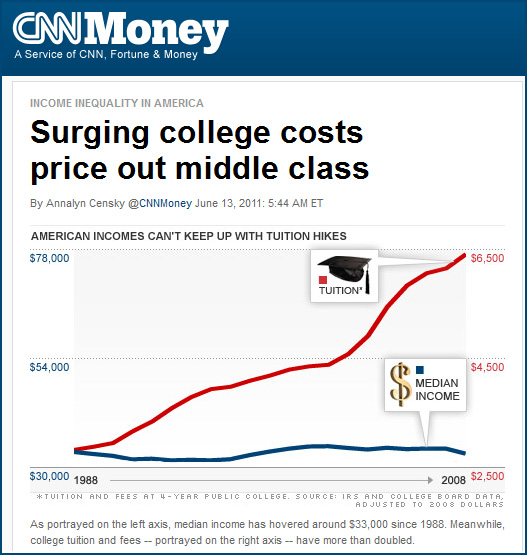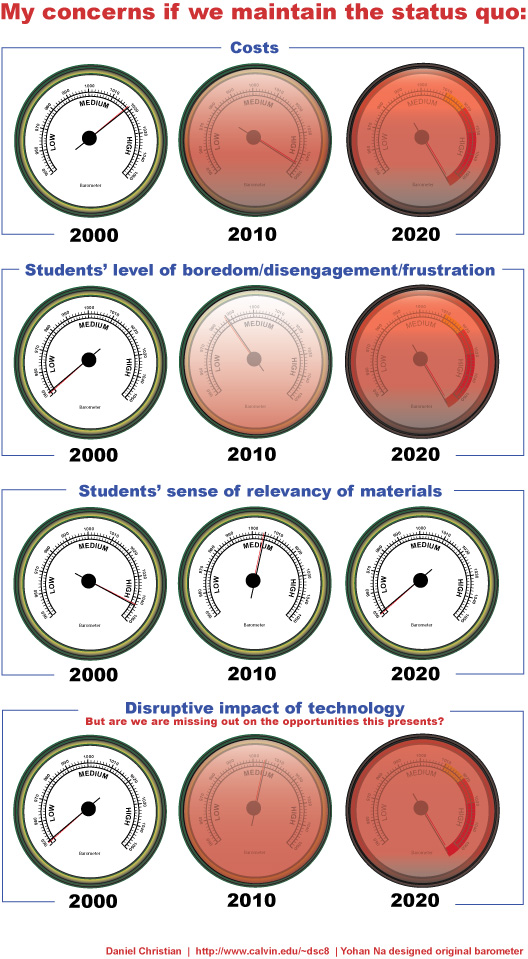From DSC: I originally saw this at
Mindstorms EV3: LEGO Education unveils its next generation robotics platform
from HackEducation.com by Audrey Watters




From DSC: I originally saw this at
Mindstorms EV3: LEGO Education unveils its next generation robotics platform
from HackEducation.com by Audrey Watters
From DSC:
Whereas:
…institutions of higher education would be wise to significantly increase the priority of experimentation on their campuses during 2013. This might take the form of creating smaller, more nimble organizations within their overall universities or colleges, or it might be experimenting with new business models, or it might be identifying/experimenting with promising educational technologies or new pedagogies, etc. I will have several blog postings re: experimentation — and potential things to try out — during 2013; so stay tuned.
Whether we are staff, faculty, or administration, change is coming our way in 2013. So starting today, get involved with further innovations and experiments on your campus — don’t be a roadblock or you will likely find your institution eventually becoming irrelevant. As Steve Jobs did/believed, cannibalize your own organization before someone else does.

From the January/February 2013 issue of The American Interest:
.
Excerpts (emphasis DSC):
…
The higher-ed business is in for a lot of pain as a new era of creative destruction produces a merciless shakeout of those institutions that adapt and prosper from those that stall and die.
…
But what happens when a limited supply of a sought-after commodity suddenly becomes unlimited? Prices fall. Yet here, on the cusp of a new era of online education, that is a financial reality that few American universities are prepared to face.
…
Anyone who can access the internet—at a public library, for instance—no matter how poor or disadvantaged or isolated or uneducated he or she may be, can access the teachings of some of the greatest scholars of our time through open course portals. Technology is a great equalizer.
Big changes are coming, and old attitudes and business models are set to collapse as new ones rise. Few who will be affected by the changes ahead are aware of what’s coming. Severe financial contraction in the higher-ed industry is on the way, and for many this will spell hard times both financially and personally. But if our goal is educating as many students as possible, as well as possible, as affordably as possible, then the end of the university as we know it is nothing to fear. Indeed, it’s something to celebrate.
* The old way:
Colleges rise as they reject — from online.wsj.com
Schools invite more applications, then use denials to boost coveted rankings

Also relevant/see:
Combine the trends listed in this graphic:
.
— from The Economics of Higher Education, Dec 2012 (pg 2)
…with the next several graphics…
.

.
.

From 5/21/09
…and you can see that the Perfect Storm in Higher Ed has been amassed. Massive change is in the air. People will find a way to achieve their goals/objectives — one way or another. College is still a good call — but what “college” and “university life” will look like in 5 years will likely be very different from what they look like today.
There is no returning to the “good ol’ days” — things are not going back to the way they were 5-10 years ago. It’s time for massive — but controlled/intentional — experimentation within higher ed, to find out how best to use the Internet in order to promote learning (and, hopefully, to still make a living!).
.

Some examples that illustrate that change is in the air…and that the conversation continues to move outside traditional institutions of higher education (I mention these not to dog higher ed, but to get us to innovate, to reinvent ourselves, and to stay relevant!)
Big idea 2013: College becomes optional — from LinkedIn.com by Ben Smith
Jailbreaking the degree: The end of the 4 year diploma — from onlineuniversities.com by Justin Marquis
Excerpt:
What’s wrong with getting a college degree? According to the grassroots movement, “Jailbreaking the Degree,” being pushed by radical education startup Degreed.com, quite a bit. The organization has identified several fundamental flaws with the long standing college degree process. It aims to overcome them and dramatically change the nature of learning and credentialing in the process. In order to justify their initiative they present some dramatic numbers on their website…
Degreed wants to jailbreak the college degree — from techcrunch.com by Rip Empson
Saying no to college — NYT.com by Alex Williams
Do a Google search on uncollege.org and see what you get
The rise of college alternatives— from huffingtonpost.com by Dan Schawbel
educreations.com: Teach what you know. Learn what you don’t.
Addendum on 12/14/12:
From DSC:
We had better step up the pace of innovating/experimenting – and move to do so quickly. But the problem is, moving quickly is not in the cultures of most of the more traditional institutions of higher education.
Also relevant:
See:
From DSC:
Here’s a developing job: Web-based proctor
.
Addendums:

.

.
From DSC, some examples:
Excerpt:
With the public’s continued focus on value and affordability, higher education finds itself at a critical juncture. Cost pressures and increased global demand for access have given rise to innovations that have unleashed new delivery models into the education marketplace. Such innovation is required if universities are to thrive, compete, and bring new relevance and meaning to the value of college in the 21st century.
Also see:
From DSC:
Experimentation. Innovation. Experimentation. Innovation. Fail. Fail. Succeed. Fail. Succeed. Fail.
The education giant adapts — from MIT Technology Review by Jessica Leber
Pearson is the world’s largest book publisher. Now it wants to be a one-stop shop for digital education.
Excerpt:
Pearson pulled this off with a decade-long string of acquisitions that helped it shift its emphasis from selling books to selling education services. The London-based company styles itself as the “world’s leading learning company,” even if that learning isn’t delivered through traditional books. These days, Pearson is more like an IT department for classrooms and schools. It sells technology infrastructure, software, and consulting services to schools—services that in turn help deliver the vast stock of textbook content Pearson owns. The company says its revenue from online content and services will surpass those of the traditional publishing business this year.
From DSC:
I congratulate Pearson on reinventing itself. The words of Steve Jobs ring in my mind…something about cannibalizing one’s business before someone else does it for you. Several other words and phrases come to my mind after seeing the above article — that regular readers of this blog and my archived website will instantly recognize:
Also relevant here/see:
From DSC:
Mr. Rob Bobeldyk and I were brainstorming last week about the need to create A Center for Innovation — a smaller organization within our overall organization — that can be far more nimble and responsive. Such a Center could be:
As I discovered HBR’s interview with John Kotter today, I felt our idea/direction/brainstorming is heading in the right direction!
.
That is, we are trying to keep the plane in flight while making some significant changes. Put another way, we are trying to keep the bread and butter in tact while experimenting with new business models and/or new products and services.
Kotter’s “Dual Operating System” affirms that a new/smaller/more nimble organization is appropriate. Here are some graphics of Kotter’s “dual operating system”:
.
.
.
The work of Christensen, Horn, and Johnson is highly-relevant here as well:
Addendums on 11/20/12:
.
From DSC:
I wonder how MOOCs focused on language will go…? It could be great to practice a language from folks all around the world — or will it be chaotic? Different accents. Real-world speaking and listening. Real world conflict, perhaps, as well. But it seems like there could be some effective learning going on — at least “on paper”. I wonder, too, if 1/2 of the time folks could speak one language — and would be the students during that part of the class — while the other 1/2 of the time they speak another language — and would be the “teachers.”
.
And for yet another item on innovation within higher ed! Whew!
College crackup and the online future — from bloomberg.com by Mark C. Taylor
.

Illustration by Keith Shore
Excerpt:
In the coming decade, emerging technologies will thoroughly transform higher education. Although distance learning and computer-assisted education have been around since the 1960s, financial pressures are forcing institutions to develop aggressive online programs.
…
These practical considerations shouldn’t overshadow one of the most promising innovations that online education will bring: The very structure of knowledge will change.
…
As students mix and match courses online, pressure will increase for professors to develop classes that integrate different approaches and disciplines.
.
.
Also see:
From DSC:
Creating “Innovation Labs” within each institution of higher education sounds like a good idea to me…we can experiment with things at smaller scales and see what works and what doesn’t.
Also see:
Take a lesson from Apple: A strategy to keep customers in your ecosystem — from forbes.com by Alonzo Canada
Excerpt (emphasis DSC):
1. Set focused, strategic targets.
2. Create a portfolio of experiments. Like Apple or Mercedes Benz, once you have focused, strategic targets set, create a series of experiments. A general rule of thumb is the 7-2-1 rule: one experiment should be big and relatively safe. Two experiments should be slightly more risky and moderately sized. Then seven experiments should be highly risky and low cost. These experiments can be scaled accordingly across teams, business units, and the entire company. 3M is one of the first companies to mandate that its employees spend 20% of their time thinking up blue sky ideas beyond its current lines of business and this is how Post-It Notes were born. Art Fry, an engineer at 3M wanted to find a better way to manage notes in his hymnal on Sundays at church.
3. Leverage learnings to inform new experiments.
Average student debt climbs to $26,600 for Class of 2011 — from The Institute for College Access & Success
Report, website include state-by-state and campus-by-campus debt levels for 2011 graduates
Excerpt:
TICAS recently released Student Debt and the Class of 2011, our seventh annual report on the debt carried by new college graduates. Hundreds of news outlets around the country have already run stories featuring our findings, including The New York Times, USA Today, and PBS NewsHour.
We found that two-thirds of college seniors who graduated from public and private nonprofit four-year schools in 2011 carried an average of $26,600 in student loan debt, up 5% from the previous year. Private student loans comprised about one-fifth of the Class of 2011’s debt. Meanwhile, unemployment for recent graduates dipped from last year’s peak of 9.1% but remained high at 8.8% (still less than half the unemployment rate for young adults with only a high school diploma).
The report also shows that average student debt levels vary widely by state as well as by college. To view debt levels for all 50 states plus the District of Columbia and more than 1,000 individual U.S. colleges and universities, visit our companion interactive map.
Read the press release
Read the report
Use the interactive map
.
From DSC:
The above items support the need for greater experimentation within higher ed.
Also see: